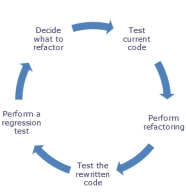This article has been published in Testing Circus – Volume 4 – Edition 12 – December 2013.

An increasing number of companies are using Agile/SCRUM to implement their software. It is quite a shift from traditional/waterfall development to the more flexible, less documented Agile/SCRUM approach. The transition often proves to be a challenge at some point.
In the book “Scaling Software Agility: Best practices for large Organisations” by Dean Leffingwell you can find some important processes that will change. Going through a couple of these processes, I will describe the impact of the transition on testing.
Changes caused by the transition
Measures of success
In traditional development the main measure of success for a project is usually on time delivery, but in Agile this changes to working code. This is a fundamental difference in measuring success. Instead of time driven, the project will be quality driven. Of course this has its impact on testing. When working code is the measure of success, we need to put more effort in providing working code. The only way for the team to find out that it is working is by testing.
In traditional development the focus for the different disciplines (such as business analysts, developers and testers) is on different aspects. In Agile the complete cross functional team needs to have its main focus on quality. To make this happen, it is important to spread the knowledge of testing across the whole team. This can be achieved by:
- using pairing to pair testers with people in other roles to facilitate implicit knowledge sharing;
- providing basic test training for the team members to explicitly focus on testing aspects of their roles.
Both of these methods can be executed by the tester in the team, but the latter of the two can also be executed by people outside the team. Testers need to communicate with all different roles in a project and help them to understand and apply testing in their context.
Management culture
Another important aspect that needs to change is the management culture. Where the keywords in traditional development are command and control, the culture needs to shift towards collaborative leadership and empowerment of teams. The impact on testing as a craft seems minimal, but the impact on the traditional test functions, such as test managers and testers, is large.
Test managers used to be responsible for test strategy, product risk analysis, test plans, test estimation, resourcing, etc. But how will this work in Agile/SCRUM?
- Planning and estimation are a team responsibility.
- Detailed product risk analysis upfront is not possible.
- Teams need a degree of freedom, so extensive strategy and plans are uncalled for.
In short, the role of test management changes. The human resources aspect of management is more important. How to get the right tester in the right team and keep the testing knowledge of the testers up-to-date? This is done by knowing the testers and their needs. Test management needs to find ways to get the necessary information out of the different (SCRUM) teams in order to have a bird’s eye view on the testing process.
Keep in mind that a lot of the previous management responsibility shifts to the teams. This requires a high rate of trust in the people and keeping away from micro management. So management needs to let go some of the control and the people in the teams have more responsibilities and need to deal with this. Mind that not everyone will feel comfortable with this, so make sure to pick the right people for the different roles in the team. Next to that: not every team needs the same type of tester.
Requirements and design
The change in requirements and design is very big and testing needs to find a way to cope with this. Where we had big upfront design, we now have continuously changing, emergent, just in time documents. This impact on testing is felt at management level and at engineering
level.
In Agile, test management cannot identify the detailed risks, since there only is a high level, global set of requirements. To retain a risk based testing approach, we need different levels of product risk analysis, abstract up front and more detailed in the teams when more detail is known. So (test)management should be able to do a high level risk assessment at product backlog level, where the team will do detailed risk assessments at the sprint backlog level.
One of the main complaints by traditional trained testers in an Agile environment is the lack of upfront requirements and designs to use as a basis for their testing. Test cases need to emerge from discussions at the grooming or planning session. Testers need to start creating test cases based on these discussions before the requirements and designs are properly documented. By having testers and designers review each other’s products you have quality control early in the process. Test cases and designs prove to have a better match and any differences can be discussed with the product owner.
Note that a good product owner is indispensable for Agile projects. Only by good product ownership, the right product gets build.
Coding and implementation
Everybody is aware of the different phases in a traditional project. Testing takes place after coding, which in its place is after design. A good practice in Agile/SCRUM is the use of test driven development (TDD). Coding and testing then go hand in hand. This increases the quality and maintainability of the code. The shift to TDD is not always that easy. Developers often don’t like to write unit tests and did not receive proper training in how to do right TDD. When used incorrectly, TDD will take a lot of time and have no or little benefits. Testing can support once again by pairing to support the developers with applying white box testing techniques.
The short development cycles and the incremental approach require a lot of regression testing. Since regression testing takes place in every sprint, test automation will save a lot of time. The impact is that people with test automation skills are needed it the team and that we need to plan for the automation. If the testers are not able to automate the tests themselves, they at least need to know what should be automated and communicate this with the automation specialist.
Overall impact on testing
Basically, we still need to test. The craft of testing is still in place and we must not forget what we learned in the past. But we need to adjust and adapt to our new context: Agile. The quick and changing world of Agile development requires a more pragmatic approach to testing. No large upfront planning and documenting, but small pieces of functionality. Pieces that are manageable by the teams. Testing goes beyond the tester; it is part of the complete team.
Automation has become an essential part of testing to keep up with the development pace in Agile. This requires the testers to have more technical knowledge and better communication skills. An early start with automation, usually results in a better maintainable product, so
enough reason to automate!
Last but not least, it’s all about people! Investing in people and skills is needed to perform well in an Agile context. Provide training in testing for all team members and don’t forget to provide training in other disciplines for the testers as well.
 First posted on the Polteq website.
First posted on the Polteq website.

 Test automation is a prominent part of testing. To improve your test automation code, you should look at development practices. Creating clean code is a good practice to improve the maintainability and readability of the test automation.
Test automation is a prominent part of testing. To improve your test automation code, you should look at development practices. Creating clean code is a good practice to improve the maintainability and readability of the test automation.
